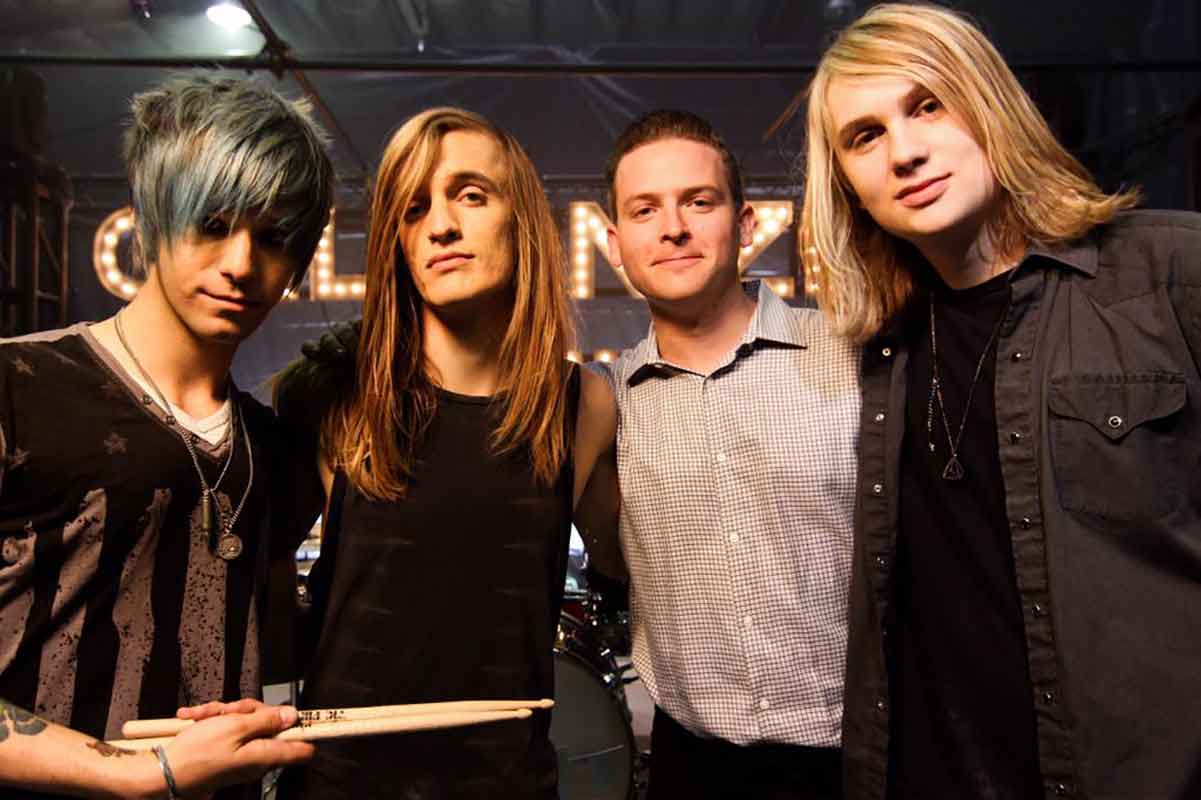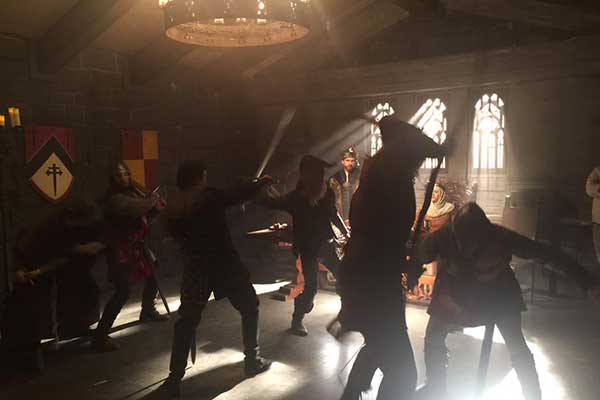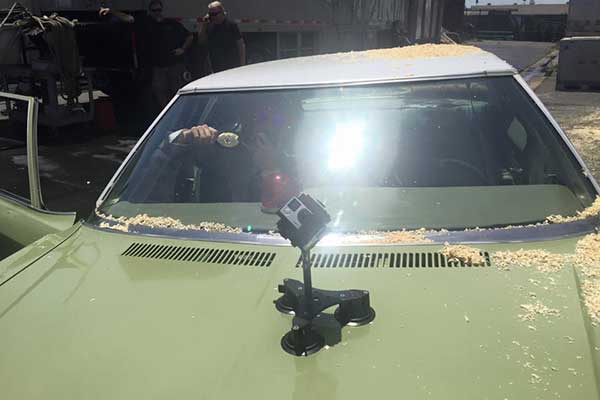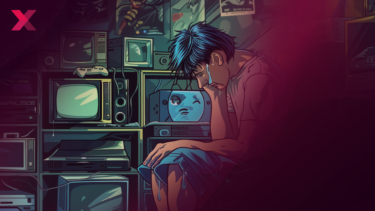Storytelling in Virtual Reality

Wie man in Virtual Reality eine Geschichte gut erzählt, weiß bisher niemand so richtig. Das Medium steckt noch in den Kinderschuhen.
Sicher ist aber: Sollen Geschichten im virtuellen Raum den Zuschauer fesseln, müssen die Eigenheiten des neuen Mediums berücksichtigt werden. Brandon Zamel von Springbok Entertainment beschäftigt sich intensiv mit Storytelling in Virtual Reality.
Springbok Entertainment ist eine Produktionsfirma für innovatives Storytelling. Auf seiner Webseite schreibt Zamel: „Wir bringen die Technologie aus dem Silicon Valley mit den Traditionen aus dem Hollywood-Kino zusammen, um neue, kreative Ideen zu erschaffen.“
___STEADY_PAYWALL___Zuletzt konnte er mit den New Deal Studios ein VR-Musikvideo für die US-Rockband Galvanized Souls umsetzen. Im Interview mit VRODO erzählt Zamel, was er dabei über das Geschichten erzählen in der virtuellen Realität gelernt hat.
VRODO: Storytelling in VR ist noch ein recht neues Thema. Was ist der grundlegende Unterschied zwischen einem klassischen und einem immersiven Medium?
Zamel: Es gibt eine Reihe von Gründen, die VR zu einem besonderen Storytelling-Medium machen. Viele resultieren daraus, dass der Geschichtenerzähler und der Zuschauer in VR eine besonders enge Beziehung eingehen.
Denn der Zuschauer muss sich der Geschichte ganz hingeben, er sagt: „Ich gebe euch 100 Prozent meiner Augen und meiner Ohren.“ Das ist eine große Verantwortung für den Drehbuchschreiber. Der Zuschauer ist viel verletzlicher. Wir müssen diese große Nähe nutzen, um eine fesselnde Story zu entwickeln, aber wir dürfen Virtual Reality nicht als Gimmick verkommen lassen. Grundsätzlich gilt: Die Geschichte muss sich natürlich entfalten, unabhängig davon, ob sie in einem immersiven oder einem klassischen Medium erzählt wird. Der Unterschied bei immersiven Medien ist, dass Erfolg oder Misserfolg der Story beim Zuschauer besonders intensiv ankommen.

Am Set beim VR-Dreh mit Galvanized Souls. Foto: Galvanized Souls
VRODO: In Virtual Reality entscheidet der Zuschauer darüber, wo er hinschaut, nicht mehr der Regisseur. Theoretisch könnte es passieren, dass der Zuschauer damit beschäftigt ist in die Wolken zu schauen, während sich vor ihm gerade die Geschichte entfaltet. Wie geht man damit um?
[blockquote cite="Brandon Zamel"]In Virtual Reality sollte man die 360°-Freiheit nicht ausnutzen, nur weil man es kann. Wir möchten, dass unsere Zuschauer ihre Umgebung erforschen und sich im virtuellen Raum präsent fühlen, aber nur, um die Verbindung zur Story herzustellen. Immersion ist keine Form der Unterhaltung oder Erzählung, sondern nur ein Werkzeug, um die Verbindung zum Zuschauer zu intensivieren. Der Regisseur opfert zwar den traditionellen Rahmen, erhält dafür aber auch ganz neue Freiheiten.[/blockquote]Zamel: Ich glaube, das ist gar kein so großes Problem. Denn unser Instinkt leitet uns. Wir schrecken zurück vor der Dunkelheit, Licht zieht uns an, laute Geräusche versetzen uns in Alarm und wir untersuchen unsere Umgebung. Ein guter Geschichtenerzähler versteht das. In Virtual Reality verliert der Regisseur seinen Rahmen, aber die Werkzeuge bleiben die gleichen. Noch wichtiger wird in Zukunft 3D-Audio sein, so dass Geräusche immer passend zur Position des Zuschauers ausgegeben werden. Auch die richtige Beleuchtung ist wichtig.
[bctt tweet="Beim #Storytelling in #VirtualReality muss man die Instinkte des Nutzers einbinden."]VRODO: Ist es wichtig, dass man einer Story in VR mehrere Dimensionen gibt? Also beispielsweise dass mehrere Handlungen gleichzeitig passieren und viele kleine Geschichten in eine großen Story verpackt sind. Möglicherweise sogar abhängig davon, wie der Nutzer sich verhält?
Zamel: Das hängt von der Zielsetzung des Geschichtenerzählers ab. Eine gute Frage, die man sich selbst stellen kann, ist: „Ich weiß ich könnte, aber sollte ich?“ Alles ist möglich mit Virtual Reality, aber das heißt nicht, dass die Story davon profitiert. Wenn das Verhalten des Zuschauers die Handlung beeinflusst, dann nimmt die Geschichte die DNA eines Spiels an. Wenn das das Ziel ist, ok, aber das bedeutet nicht, dass es nicht auch tolle VR-Erfahrungen ohne Interaktion geben wird. In der Musik sagt man, die Noten, die man spielt, sind genauso wichtig wie die Noten, die man nicht spielt.
VRODO: Könnte Virtual Reality das Medium sein, das die Grenze zwischen Film und Spiel komplett verwischt? Viele sprechen von einer VR-Erfahrung, nicht von einem VR-Film oder VR-Spiel.
Diese Grenze verwischt schon seit einiger Zeit, auch ohne Virtual Reality. Filme wie Transformers erinnern eher an Zwischensequenzen aus einem Videospiel, Uncharted oder die Spiele-Adaptionen von Walking Dead und Game of Thrones sind fast wie spielbare Filme. Ich glaube nicht, dass VR die beiden Medien noch näher zusammenbringt, aber ich glaube, dass es noch mehr Überschneidungen geben wird. Daher sprechen wir häufig von VR-Erfahrungen, da Virtual Reality niemals "nur ein Spiel" oder "nur ein Film" ist. Die Menschen, die in Zukunft Inhalte für Virtual Reality erstellen, werden sich etablierten Konzepten und Werkzeugen aus klassischen Medien bedienen und dabei eine eigene Sprache speziell für Virtual Reality entwickeln.
[bctt tweet="#VirtualReality ist niemals nur ein Spiel oder nur ein Film."]VRODO: Du hast vor kurzem gemeinsam mit den New Deals Studios ein VR-Musikvideo produziert. Was hast Du dabei gelernt?
Zamel: Unser Ziel war es, das erste immersive Musikvideo mit einer starken Handlung zu drehen. Der Song heißt „New Generation“ von Galvanized Souls, einer Band aus Kalifornien, die das VR-Video als Teil ihres kreativen Outputs angenommen hat. Matthew Gratzner von den New Deal Studios hat das Drehbuch geschrieben und Regie geführt. Es gibt schon einige VR-Musikvideos, viele wirken aber eher wie Techdemos. Wir wollten sicherstellen, dass die VR-Erfahrung gut zum Song passt und haben einige Dinge probiert, die bisher nicht in Virtual Reality probiert wurden. Autounfälle, Explosionen, ein komplett immersives Set. Jede Aufnahme war sehr planungsintensiv.
[blockquote cite="Brandon Zamel"]Wenn man kinoreife Filme für Virtual Reality umsetzen will, muss man viel mehr beachten als bei traditionellen Produktionen fürs Kino. Diesen Mehraufwand sollte man in der Zeitplanung berücksichtigen, das kommt dem Projekt zugute.[/blockquote]VRODO: Auf welche VR Hard- und Software freust Du dich in den kommenden Monaten am meisten?
Zamel: Kameras. Ich freue mich immer über neue Kameratechnologie. Im Moment ist die Postproduktion für Virtual Reality sehr arbeitsintensiv und die Qualität, die am Ende rauskommt, ist noch nicht ausreichend gut. Mit besseren Kameras werden wir auch deutlich bessere VR-Produktionen sehen.

360-Kameras sind am Set mit Brandon Zamel auch mal auf der Motorhaube. Foto: Zamel / Galvanized Souls
VRODO: Virtual Reality ist schon seit Jahrzehnten immer wieder ein Thema. Die Menschen fasziniert die Vorstellung einer virtuellen Realität, in der die Möglichkeiten grenzenlos sind. In der Vergangenheit sind aber alle Versuche gescheitert den Massenmarkt für VR zu öffnen. Was ist diesmal anders?
Zamel: Technologie und Preis sind jetzt an einem Punkt an dem VR für eine Durchschnittsperson zugänglich ist. Ob es vom Markt angenommen wird, hängt allein von der Qualität der Inhalte ab und ob die Industrie ihren Zuschauern das neue Medium schmackhaft machen kann. VR-Brillen erscheinen ab Ende 2015, noch mehr neue Modelle werden für 2016 erwartet. Speziell Mobile VR, also Virtual Reality mit dem Smartphone, wird viele Nutzer ansprechen.
VRODO: Wird die Nachfrage nach diesen Smartphone VR-Brillen größer sein als nach kompakten VR-Brillen wie Oculus Rift oder HTC Vive?
Zamel: Diese Frage ist schwierig zu beantworten, denn die Inhalte werden sehr unterschiedlich sein. Es ist ein bisschen wie Äpfel und Orangen zu vergleichen. Oculus, Valve und Sony sind sehr auf den Gaming-Markt fokussiert. Mobile VR eignet sich besonders gut für immersive Videos und kurze Spiele. Ich denke, es gibt einen Markt für all diese Brillen.
VRODO: Möglicherweise sehen wir auch ein Revival der Virtual-Reality-Spielhallen, beispielsweise The Void. Das lässt sich natürlich auch auf das Kino übertragen, beispielsweise in einem speziellen VR-Vorführsaal.
Zamel: Es wird definitiv einen Markt für High-End-VR-Erfahrungen geben, beispielsweise in Vergnügungsparks oder bei ähnlichen Anlässen. Ich glaube, dass diese High-End-VR-Erfahrungen ein Fingerzeig sind, wie wir in Zukunft Unterhaltung und Information konsumieren und damit interagieren.
[section label="English Version: Storytelling in Virtual Reality"]
English Version: Storytelling in Virtual Reality, Interview with Brandon Zamel from Springbok Entertainment
[toggles behavior="toggle"] [toggle title="Click to read"] VRODO: What is the most crucial difference between developing a story for Virtual Reality in comparison to a traditional, framed medium?Brandon Zamel: There are a number of elements that make VR an incredibly unique storytelling medium. Many of these stem from the intimacy exchange a storyteller has with their viewer. There is a significant level of commitment a viewer gives to an experience in VR that is unlike traditional media like film and television. They are essentially saying, “I give you 100% of my eyes and ears” it is our job to make that exchange worth it to them. The burden on us as storytellers is much higher because our audience is more vulnerable. With this in mind, we must utilize that intimacy to deliver the most compelling experience we can while at the same time not rely on it as a gimmick. Narrative must naturally unfold and act as the driving mechanism that pushes your audience forward, no matter if it is immersive or framed. The difference with immersive experiences is that the success and failures are that much more heightened.
MIXED.de ohne Werbebanner
Zugriff auf mehr als 9.000 Artikel
Kündigung jederzeit online möglich
VRODO: In Virtual Reality, the user decides where he or she is looking at, not the director. So basically it could be happening that the user is busy looking
in the sky instead of noticing the major plot point. How do you overcome that issue?
Zamel: This is often brought up, but I believe this is less of an issue than it really suggests. Our instincts guide us. We shy away from the dark, we’re attracted to light, loud sounds put us on alert, we observe our surroundings. A good story teller already understands this. VR gets rid of the frame, but many of the triggers remain.
We rely on traditional tools as well as the evolving discourse of immersive story telling. The crucial role of audio is often overlooked. With the advances that are happening in positional 3d audio, sound will continue to play a bigger and bigger role in VR. Lighting is another factor.
One unique consideration for the medium is not to exploit the 360 degree space. Just because you can put action behind your viewer doesn’t mean you should. We want audiences to explore their environment and experience presence, but once again, as a way to magnify the emotional connection to the story. Immersion is not entertainment nor narrative, it is a tool to strengthen the bond with the viewer. A director loses the tool of the traditional frame, but gains the potential of so much more with VR.
VRODO: Is it crucial to give a story several dimensions in VR? For example several things happening at the same time, like, having multiple small stories within one bigger story. Depending on how the user behaves, where he or she is looking. Giving the user a chance to influence and to change the story so that its outcome is a more believable, more consistent virtual world.
Zamel: It depends on what the goals of the experience are. A good question to ask oneself is “I know I can, but should I?” Anything is possible with VR, but that doesn’t mean it’s necessary or even beneficial. A person’s impact on the way an actual experience unfolds starts taking on the DNA of a game. If this is the goal of the project, then of course it’s important. But that doesn’t mean it’s required to deliver a compelling VR experience.
Additionally, to build off of what I touched on earlier, just because you have 360 degrees to work with doesn’t mean you have to have something going on at all times. Subtlety and simplicity can be just as powerful in VR as a blockbuster display. To borrow a saying about music, it's just as much about the notes that you don't play as the ones you do.
VRODO: Could it be that Virtual Reality is the medium that brings games and movies much closer together than ever before as in “experience” instead of just “game” or just “movie”?
Zamel: The line between games and film has already been merging for a while without the help of VR. One only has to look at films like Transformers that play out like extended videogame cut scenes, or games like Uncharted or any of the Telltale games, Walking Dead, Game of Thrones and so on. It's not that VR will force the two closer together, but rather the VR medium allows for more roads to intersect. Perhaps this is because, to borrow your word, "experience" is so important to VR. By its very definition VR can never be "just a game" or "just a movie". For those of us creating content for VR, we will adapt whatever concepts, tools and discourse exist in established mediums as we develop our own language for VR.
VRODO: A few weeks ago you created a 360-VR-music-video together with New Deals Studio. Any learnings you want to share?
Zamel: We set out to create the first immersive music video with a strong narrative. The video is for the song "New Generation" by Galvanized Souls, an incredible band from Somis, California that is fully embracing VR as part of their creative output. Matthew Gratzner of New Deal Studios wrote and directed the video.
There have been a handful of VR music videos, but for the most part the experiences play out like tech demos. "New Generation" is a great song. We wanted to make sure the VR experience was just as compelling as the music. We tried a lot of things that no one has done before; car crashes, explosions, fully immersive sets. A lot of planning went into every shot. With that said, one has to be prepared for the unexpected. With cinematic VR you have a lot more you are contending with than with traditional cinema. If scheduling permits, give yourself the time for these unforeseen
challenges. It will benefit the project and in turn, benefit the VR medium as a whole.
VRODO: What are you most excited for when new virtual reality hard- and software arrives in the coming months?
Zamel: Cameras. I am always excited for new camera technology. Currently, the post production work that has to be done is very labor intensive and ultimately produces footage that is not where we need it to be with quality. As good camera solutions become available we will start seeing an influx of great content, which is good for all of us in VR.
VRODO: VR was somehow always a topic for the last 30 years, mostly in the context of sci-fi stories. All attempts to bring VR to the mass market failed so far. Do you believe that VR is here to stay now? How quick will the adoption be in the mass market?
Zamel: Technology and price point has made VR accessible to the average person. Whether or not it is adopted by the mass market will depend on the quality of the content that is produced and how successful the industry is at educating the potential consumer base. We will see the consumer ready headsets begin to roll out at the end of this year and continue throughout next year. Mobile VR will be a major entry point for the average consumer.
VRODO: Do you see more demand for mobile devices like Cardboard or Gear-VR or do you think dedicated VR-Googles will dominate the market?
Zamel: This is the difficult question to answer. The content that will thrive on mobile vr platforms is not necessarily what will thrive on headsets like the Oculus Rift, Vive and Morpheus, and vice versa. Because of this, we are talking about apples and oranges. Oculus, Valve and Sony have already stated they are focused on gaming experiences. Mobile vr, in its current state, is great for immersive video and shorter gaming experiences. Both mobile and pc driven headsets can equally succeed.
VRODO: It seems like there is a chance that with VR starting to grow we could see a revival of 80s and 90s concepts like Arcades, f.e. The Void, and 3D- and VR-cinemas. Do you think that could be a good way to help the acceptance of new virtual technologies within the society?
It's inevitable that higher end, environment based vr experiences will make their way into the marketplace, via theme parks and venues that can host such technologies. For example. we have a restaurant entertainment chain in the USA called Dave And Busters that already has a history of having VR experiences at their establishments, and are continuing to expand with these types of attraction. I don't believe these types of experiences are what will convince people to accept these new technologies as much as it is indicative of an overall shift in the way we interact and
consume entertainment and information as a whole.
Hinweis: Links auf Online-Shops in Artikeln können sogenannte Affiliate-Links sein. Wenn ihr über diesen Link einkauft, erhält MIXED.de vom Anbieter eine Provision. Für euch verändert sich der Preis nicht.




